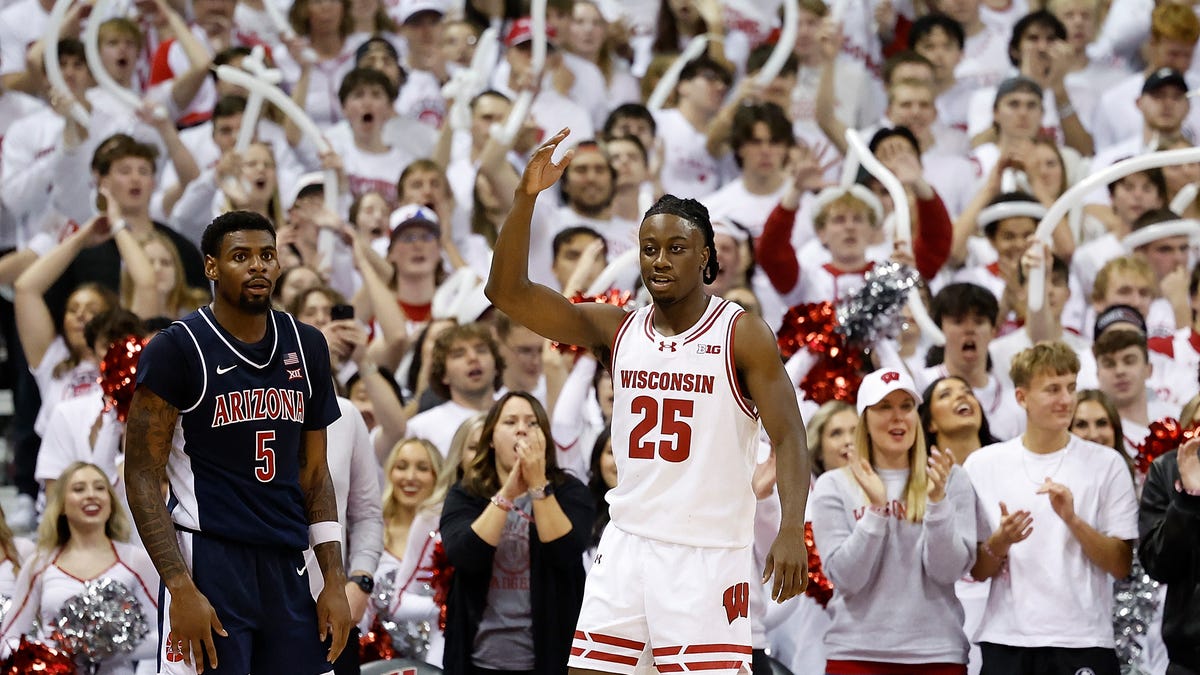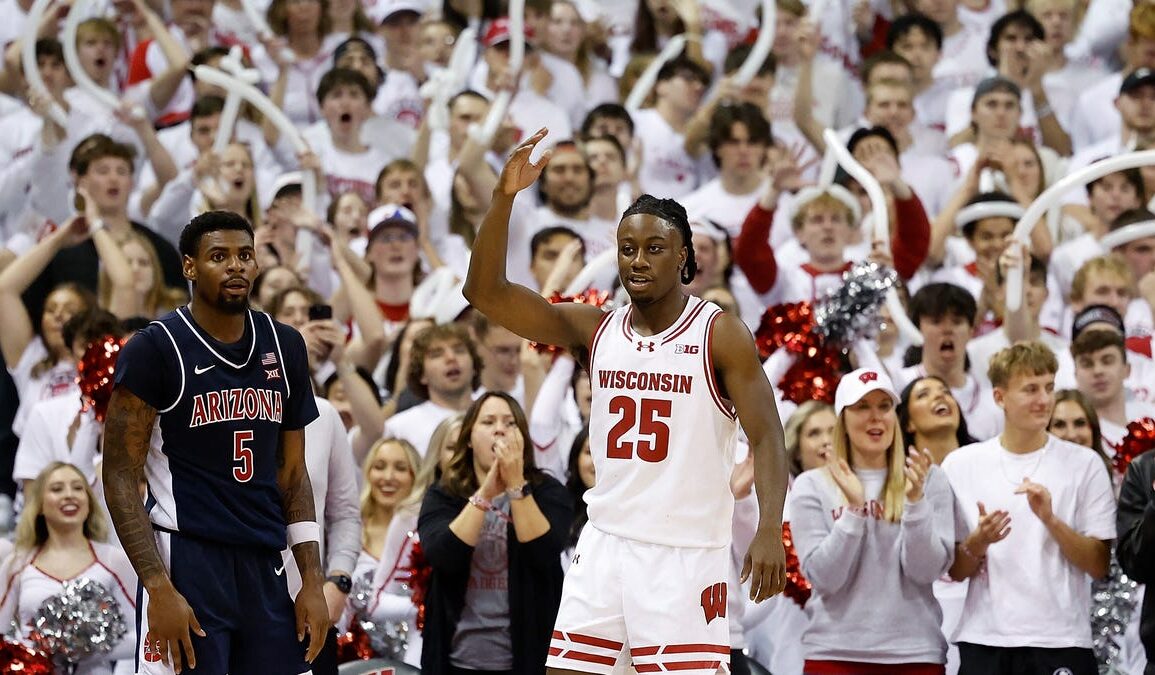
It was a busy weekend of preview work for the 2025-26 college basketball season here at Badgers Wire. First, we returned to an offseason staple of ranking the conference’s 18 basketball venues, as well as its uniform combinations.
Notably, we also evaluated the Big Ten Conference landscape for the upcoming season by focusing on each team’s returning production. Those numbers can be combined with our latest offseason power rankings to forecast the upcoming 2025-26 campaign and establish expectations for each of the conference’s 18 members.
Now, in line with our recent basketball venue rankings, it’s time for a unique look at the Big Ten landscape: An evaluation of the in-game atmospheres of each of its home arenas.
Where is the toughest place in the Big Ten to play as a road team? Which teams are elevated by a top-tier home environment? How does stadium atmosphere correlate with an arena’s overall ranking? The answers to those questions and more can be found in our power ranking of the Big Ten’s 18 basketball arena atmospheres.
18. Galen Center (USC Trojans)
Capacity: 10,258
Stadium Rank: No. 17
Team success, or the lack thereof, plays a role in some of these rankings. USC had a strong run under Andy Enfield through the 2010s. However, there’s much more to do in Los Angeles during the winter months than watch a fringe-NCAA Tournament team play.
Get more (USC) news, analysis, and opinions on Trojans Wire
17. Bryce Jordan Center (Penn State Nittany Lions)
Capacity: 15,261
Stadium Rank: No. 18
Penn State has had some moments in the Bryce Jordan Center, including wins over then-No. 11 Wisconsin and No. 12 Illinois during the 2023-24 campaign, plus a triumph over No. 8 Purdue last year. Still, the arena itself doesn’t generate a top-tier atmosphere. Many of the seats are set back from the court, creating more of an NBA feel.
Get more (Penn State) news, analysis, and opinions on Nittany Lions Wire
16. Value City Arena (Ohio State Buckeyes)
Capacity: 18,809
Stadium Rank: No. 16
Ohio State’s ranking should come with the following disclaimer: Just because Value City Arena sits near the bottom of this power ranking, that doesn’t mean the arena has a bad atmosphere. However, the stadium’s size hurts its standing, as it’s too big to create a true college basketball feel.
Get more (Ohio State) news, analysis, and opinions on Buckeyes Wire
15. Alaska Airlines Arena (Washington Huskies)
Capacity: 10,000
Stadium Rank: No. 11
Alaska Airlines Arena can be an extremely tough place to play when Washington is good. Unfortunately, that hasn’t been the case more often than not over the last decade.
Get more (Washington) news, analysis and opinions on Huskies Wire
14. Pinnacle Bank Arena (Nebraska Cornhuskers)
Capacity: 15,500
Stadium Rank: No. 15
Nebraska’s Pinnacle Bank Arena is trending positively on this list. The arena is only 12 years old and houses a program that has mostly struggled over the last three decades, having made just three NCAA Tournaments since 1995. The Fred Hoiberg-era Cornhuskers are bringing this arena to life, however. It wouldn’t be a surprise if it rises dramatically on next year’s list.
Get more (Nebraska) news, analysis, and opinions on Cornhuskers Wire
13. Williams Arena (Minnesota Golden Gophers)
Capacity: 14,625
Stadium Rank: No. 13
Minnesota’s home atmosphere at Williams Arena would rank among the best in the conference if the Gophers found a sustainable winning formula. The arena itself creates a fantastic environment, evidenced by the program’s five ranked wins in the building from 2018-20.
12. Matthew Knight Arena (Oregon Ducks)
Capacity: 12,364
Stadium Rank: No. 10
Oregon has been one of college basketball’s more consistent winning programs since Dana Altman’s arrival in 2010. Its specific place in the Big Ten is still to be determined. But a perennial 25-win team usually leads to a strong home environment.
Get more (Oregon) news, analysis and opinions on Ducks Wire
11. Welsh-Ryan Arena (Northwestern Wildcats)
Capacity: 7,039
Stadium Rank: No. 14
The new Welsh-Ryan Arena is a major upgrade over the old, pre-renovation version. The arena’s atmosphere took a significant step forward, which is partially due to the program’s success under coach Chris Collins. For a 7,000-seat arena, the new Welsh-Ryan Arena punches way above its weight.
10. Carver-Hawkeye Arena (Iowa Hawkeyes)
Capacity: 14,998
Stadium Rank: No. 8
Carver-Hawkeye Arena became a dangerous place to visit during the height of the Fran McCaffery era. The Hawkeyes’ program-best run from 2018-23 saw the building at its height for the men’s program. The Caitlin Clark era raised it to even greater heights, making the arena the place to be to watch women’s college basketball. That record run factors into the arena’s strong standing.
Get more (Iowa) news, analysis and opinions on Hawkeyes Wire
9. Kohl Center (Wisconsin Badgers)
Capacity: 17,287
Stadium Rank: No. 6
This ranking may surprise some Wisconsin fans. The Kohl Center, as a building, ranks among the best in the conference. But its atmosphere does not. That is due to several factors, including its larger size and extended premium seating around the court. The arena’s big-game atmosphere remains second only to a few, though that atmosphere isn’t consistent enough game-to-game.
8. Pauley Pavilion (UCLA Bruins)
Capacity: 13,800
Stadium Rank: No. 3
Pauley Pavilion has more history than almost any other arena in college basketball. Atmosphere-wise, it is already one of the toughest places to play in the Big Ten. That reality is even more impressive when considering the Los Angeles, California, weather in February.
Get more (UCLA) news, analysis, and opinions on UCLA Wire
7. Crisler Center (Michigan Wolverines)
Capacity: 12,707
Stadium Rank: No. 5
Michigan’s Crisler Center shares a characteristic with some of the top arenas in the conference: Its student section surrounds the court, placed right behind each team’s bench and the scoring/broadcasting table. The arena’s overall atmosphere is terrific. That in-game feel is heightened by its placement of the students.
Get more (Michigan) news, analysis, and opinions on Wolverines Wire
6. Xfinity Center (Maryland Terrapins)
Capacity: 17,950
Stadium Rank: No. 7
Maryland’s Xfinity Center might not be a household name like Assembly Hall, Pauley Pavilion, or Mackey Arena. But the arena’s atmosphere stacks up favorably. It creates an impressive college feel, even with an 18,000-seat capacity.
5. Assembly Hall (Indiana Hoosiers)
Capacity: 17,220
Stadium Rank: No. 1
Indiana’s Assembly Hall is our top arena in the Big Ten. While its atmosphere is among the best, it has slipped in the last few years. That trajectory is in line with the program’s general on-court struggles. The arena’s atmosphere has one of the highest ceilings in the conference. Entering 2025-26, the program needs to help return it to that ceiling.
4. Jersey Mike’s Arena (Rutgers Scarlet Knights)
Capacity: 8,000
Stadium Rank: No. 12
Jersey Mike’s Arena sees the biggest difference between our overall arena rankings and this specific look at each stadium’s atmosphere. While the Scarlet Knights are far from a Big Ten contender, Rutgers’ home atmosphere consistently delivers. The stadium’s unique construction contributes to this standing.
3. State Farm Center (Illinois Fighting Illini)
Capacity: 15,544
Stadium Rank: No. 9
Illinois’ State Farm Center is one of the toughest places to play in college basketball. Like Michigan’s Crisler Center, the arena surrounds a significant portion of the court with the student section. An energetic fan base and a winning program help bring this building to life all winter.
2. Breslin Center (Michigan State Spartans)
Capacity: 14,759
Stadium Rank: No. 4
Program success is a significant contributor to these rankings. Thanks to a Hall of Fame 30-year run from Tom Izzo, Michigan State has one of the best home environments in college basketball. A big part of that environment is the student section, which is arguably the best in the Big Ten. Its placement and consistent energy make every game feel significant.
Get more (Michigan State) news, analysis and opinions on Spartans Wire
1. Mackey Arena (Purdue Boilermakers)
Capacity: 14,240
Stadium Rank: No. 2
No Big Ten basketball atmosphere tops Mackey Arena’s. The building is arguably the loudest in the Big Ten, thanks to a raucous student section and energetic fan base. There’s a reason that it’s a massive surprise whenever Purdue loses a home game.
Contact/Follow @TheBadgersWire on X (formerly Twitter) and like our page on Facebook to follow ongoing coverage of Wisconsin Badgers news, notes and opinion
This post was originally published on this site be sure to check out more of their content.









